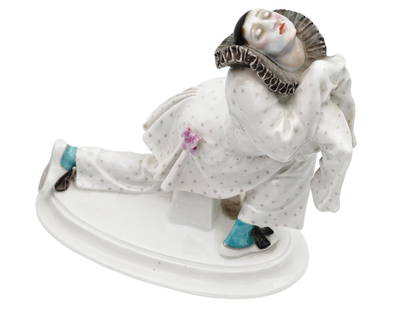
Meissen, The Good Mother, Group of Figures, 20th C.
Similar Sale History
View More Items in Figurines & StatuettesRelated Figurines & Statuettes
More Items in Figurines & Statuettes
View MoreRecommended Decorative Objects
View More








Item Details
Description
Porcelain Manufactory Meissen, after 1934
Model: Johann Eleazar Zeissig, called Schenau (1737-1806) - German painter and sculptor as well as director of the Academy of Fine Arts in Dresden; design around 1774
Underglaze blue swords mark, engraved model number ‘E69’ and impressed form number ‘111’ on the underside
Height: c. 22 cm
1st choice
Provenance: Private collection, Germany
The model widely follows a drawing by Johann Eleazar Zeissig, called Schenau, entitled ‘The Happy Mother', which is now in the print room in Dresden (Inv. No. C 1874-16). With the design of Schenau, whose work was influenced by Jean Baptiste Greuze's painting, the French style, regarded as up to date, was introduced into the manufactory.
Condition:
The figure is in very good condition, according to age, showing a few tiny strokes of restoration on the basis.
Johann Eleazar Zeissig, called Schenau (1737-1806)
Born in Großschönau, Johann Eleazar Schenau received a training in drawing under Charles-François de Silvestre in Dresden. From 1756 to 1770, he stayed in Paris and studied at the Académie de Royale de Peinture et de Sculpture. The works of Jean-Baptiste Greuze particularly influenced him. In the following years, he studied porcelain painting, which he got to know at the Porcelain Factory Sèvres. He made drawings for gold workers, copper cutters, and sculptors. He also built a reputation as a respected genre painter in Paris and received commissions from the Crown Princess of France. Back in Dresden, he became director of the drawing school at the porcelain factory Meissen. He worked as a professor of porcelain drawing and designed models himself. In 1774 he was appointed professor for genre and portrait painting at the Dresden Academy of Fine Arts. In 1796 he ceased working for Meissen.
Porcelain Factory Meissen
Porcelain has been known in Europe since the 13th century, but always had to be imported from China. Thus, it was mostly of lower quality – the Chinese rarely gave their best ware to the foreigners – and extremely expensive. As demand for porcelain became greater, European alchemists tried to discover the formula to create hard-paste porcelain. The production of the first European hard-paste porcelain was the result of a collaboration between the alchemist Johann Friedrich Böttger and the scientist Ehrenfried Walther Graf von Tschirnhaus at the court of Augustus the Strong, Elector of Saxony, in Dresden. As a matter of fact, it was finally achieved for the first time in Europe in 1708 to produce a white hard paste porcelain and in 1710 Augustus established Europe’s first hard-paste porcelain factory in the Albrechtsburg, a palace in Meissen. The so-called ‘Böttgerporzellan’ had more of a stoneware quality and it was not until the year 1713 that white porcelain was available for purchase. Initially unmarked, the motif of the ‘crossed swords’ was developed in the early 1720s and used from 1723 onwards. Since then, beautifully modelled and painted figures and table services were produced at Meissen, establishing its reputation as the pre-eminent porcelain factory in Europe. Outstanding potters, modelers and painters, e.g. Johann Joachim Kändler (1706-1775), Johann Gottlieb Klinger (1701-1781) and Count Camillo Marcolini (1739-1814), were employed at the factory, which dominated the 18th century style of porcelain, and Meissen wares and figurines were imitated by craftsmen at other porcelain factories throughout Europe. Meissen celebrated its 300 years of existence in 2008. Until today, Meissen porcelain is known for highest quality and originality and greatly appreciated. (cko)
Shipping costs excl. statutory VAT and plus 2,5% (+VAT) shipping insurance.
Buyer's Premium
- 29.75% up to €1,000,000.00
- 23.8% up to €2,000,000.00
- 17.85% above €2,000,000.00
Meissen, The Good Mother, Group of Figures, 20th C.
Shipping & Pickup Options
Item located in Berlin, dePayment




















































































